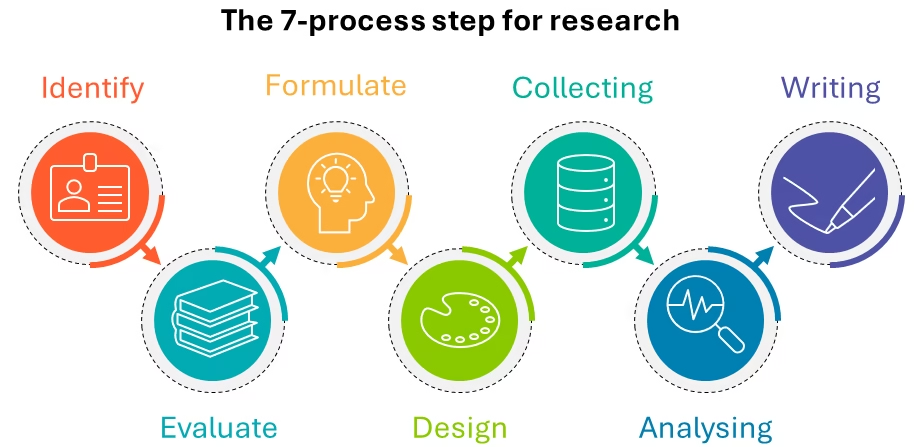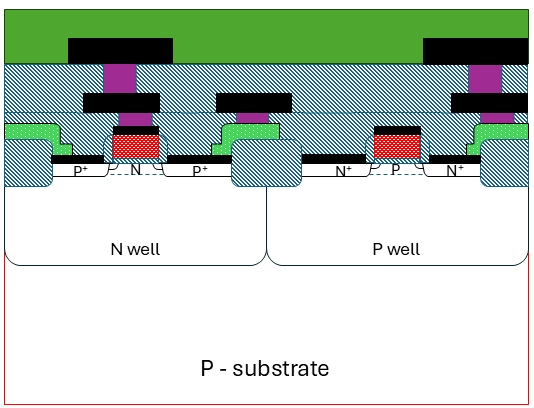1. The purpose of writing for your research
Who was the first person on the moon? What is hidden inside the Pyramids? How do computer chips work? Why is the sky blue? For some of these questions you may know the answer to, and for the others you may have to google them. Either way, you are looking them up in a printed book or online article; you are performing research.
At some point in your life, you will start looking up certain answers to questions that your boss, your mother or maybe your teacher asked you. These questions may be straightforward or require a more in-depth analysis of available information. This section aims to guide you through the research process and teach you how to effectively document your findings.
When conducting research, it’s important to present your findings in a clear and organized manner. This can take the form of a presentation or a written paper, and it’s crucial to know how to effectively communicate your thoughts and gathered facts. Remember, “Facts Tell, Story Sells,” so it’s important to create a narrative that supports your answer to the research question.
Research is an essential aspect of both academic and professional careers, which is why it’s important to invest time and effort into it. Your research should be professional and showcase your skills to potential employers.
1.1 Research writing process
Conducting research can be a complex and challenging task, but by following a few basic steps, it can be made much more manageable. The first step is to start with a broad overview of your topic and gradually narrowing your focus as you delve deeper into your research. The second step is to document your findings in a clear and concise manner. Writing academic papers, theses, dissertations or manuscripts takes time, effort and planning. Many students struggle with knowing where to begin. To overcome this, it’s essential to plan and organize your research in advance, and to regularly review and revise your work, either independently or with the guidance of a supervisor. This guide aims to assist you in these research writing processes and to help you develop your own unique research.

2. How to develop a research proposal
To effectively conduct research, it’s important to begin by formulating a clear and well-defined research question. This will help guide the entire research process and make it easier to understand and tackle the problem at hand.
The problem can take various forms, such as a practical issue that requires further examination or a theoretical problem that requires deeper understanding. Once you have identified the problem, it’s important to understand why research is needed and what it may solve by reading existing literature and discussing with others.
Gathering and evaluating information is a crucial step in the beginning of your research. This can include reading literature studies on your topic, even if they may not be as reliable as peer-reviewed papers, it can help you understand the concept of the problem, and identify interesting angles.
By this point, you should have a general knowledge of similar literature, and be able to formulate a unique and well-defined hypothesis that can be answered by qualitative and quantitative research methods. Your hypothesis will act as a guideline for your work and will help you focus on your research question. Keep in mind that your working thesis is subject to change as you learn more about the topic. Additionally, ensure that the research question you have in mind can be answered by the tools you have at your disposal.
3. Managing your research
Once you have chosen a topic, identified the problem and formulated a hypothesis, it’s important to develop a detailed plan for your research project. A well-crafted plan helps ensure that your project runs smoothly and that each step of the process is given the necessary time and attention.
One effective approach is to design your project from the deadline backwards. Start by determining your final submission date, and then work backwards to plan when your report or manuscript should be finished, when writing should begin, and when research should commence. Breaking your project down into smaller tasks can also help you stay organized. For example, when conducting research, you can plan ahead for when you’ll need to book instruments or travel to a specific location.
It’s important to remember that unforeseen events may occur and disrupt your schedule, so it’s essential to review and update your plan frequently. Anticipating potential setbacks can also help you minimize any negative impacts they may have on your project.
Lastly, it’s important to design your research project in a way that you have the necessary tools at your disposal to solve your problem. This could be a laboratory bench for a physics problem or the appropriate questionnaire for surveying a large group of people.
4. Obtaining data
Once you have developed and planned your research project, it’s time to actively engage in research. This includes efficiently locating and collecting data, and reading sources, taking notes, and considering how the information will be used in your project. Resources can be classified into two categories: primary and secondary sources. Primary sources are direct sources of information or data, such as research articles, autobiographies, and literary texts. Secondary sources analyze, interpret, or discuss the information found in primary sources, such as magazines, television, and reviews. It’s important to understand the difference between these two types of sources and to know which one is appropriate for your project.
Efficiently locating resources is also crucial, as you don’t want to waste time reading irrelevant articles. One effective strategy is to identify key terms and phrases that are important to your research, and use them as keywords when searching for sources. You can also look at the reference lists of relevant papers, or use Google Scholar to find sources, but limit your search results to a specific time frame or language to avoid being overwhelmed with irrelevant results.
As you gather sources, it’s important to remain critical and question their relevance and reliability. Ask yourself if a source is truly relevant to your research and if it can contribute anything valuable. Additionally, evaluate if the source is trustworthy and reliable. These questions will help you to stay focused and ensure that the sources you use are of high quality.
4.1 Relevance
Reading every source takes too much time, you’ll want to weed through all the articles and books. This can be done by skimming the introduction and conclusion and look at the figures and subheadings.
4.2 Reliable
Not all sources are created equal, and it’s important to evaluate the reliability of the sources you use in your research. One way to determine the reliability of a source is by identifying whether it has been peer-reviewed. Additionally, the journal in which the article is published can provide insight into its reliability, with higher impact factors generally indicating more reputable journals. However, it’s important to note that a journal’s impact factor is not the only indicator of reliability and that some lower impact journals may still have a rigorous peer-review process.
High-quality sources for research include scholarly books and articles in reputable journals, as well as government documents and information from reputable organizations such as universities and research institutes.
Sources of varied quality can also be useful, but may not have the same depth of information as high-quality sources. Examples include news stories and popular magazine articles.
Low-quality sources should be avoided, as they may be questionable and written for a general audience, giving the opinion of the writer. Examples of low-quality sources include radio programs and TV news shows with biases, or personal blogs.
4.3 Managing sources
Keeping your work organized is crucial, especially when it comes to the sources you use in your research. One essential step is to create a bibliographic list of all the information you use, including the authors’ names, titles of books or articles, page numbers, and URL or DOI addresses. This is especially important if your project spans several months or years, as it can be difficult to remember where you obtained certain pieces of information after such a long time. Starting your bibliography early on can save you hours of work in the long run.
Similarly, it’s important to keep track of your notes, whether it be online or in a physical folder, easily accessible. These notes should contain enough information to locate the source easily, such as the authors’ names, titles of books or articles, page numbers, and URL or DOI addresses. At the end of your project or research, you’ll need to write these sources down in a reference list, in a specific format, such as APA, IEEE, or MLA style. Keep this in mind as you take notes and organize your sources.
Related: References & Citations
5. Critical thinking
As you move forward in your research, you should have started collecting data and may be preparing to write a draft of your manuscript or article. This stage of the process can be challenging, but with the right approach, you can make a smooth transition from data collection to writing.
Instead of diving straight into writing, it’s important to first analyze your data and reflect on what you’ve learned. Ask yourself questions such as “What have I learned?” and “How do the sources complement each other and are there any recurring facts?” This will help you gain a deeper understanding of your data and identify key insights.
Next, review all the information you’ve gathered and synthesize an answer to your research question. Look for connections and relationships between your sources, and pay attention to facts that are repeated in different sources, even if the sources may disagree on major concepts. These small details can be important for identifying the ideas to discuss in your paper.
As you analyze your data, keep in mind that it’s important to address any contradictions between sources. However, it’s not always appropriate to discard sources simply because they do not agree with your point of view. Carefully consider each source and its relevance to your research. By following this approach, you can ensure that your manuscript or article is well-organized, informative and reliable.
5.1 Re-evaluate
As you analyze the information you’ve gathered, it’s important to be open to the possibility that your working thesis may require revision. The research process is dynamic, and it’s not uncommon for your ideas or understanding of a topic to change as you gather and analyze new information.
It may be necessary to refine your thesis statement to better reflect the insights and understanding you’ve gained through your research. This could involve rewording your thesis to more accurately capture your findings or adjusting your focus to include new perspectives or information.
It’s important to remember that a thesis statement is not set in stone and should be flexible enough to adapt to the evolution of your research. Keep in mind that a well-written thesis statement is a clear, concise and specific representation of the main idea of your research paper. By revising your thesis statement in light of new information, you can ensure that it accurately reflects the insights and understanding you’ve gained through your research.
5.2 Plan how to organize your report/paper/manuscript
Integrating your ideas and research findings into a written report is a complex process that requires time and planning (see How to write a dissertation manuscript). The amount of time required for this task can vary, with writing papers taking several weeks, and a PhD manuscript potentially taking up to half a year. To ensure that you have enough time to complete your report, it’s important to plan ahead and schedule your time effectively.
Similar to the approach you took in the planning stage of your research, you can start by setting a deadline and working backwards to schedule important events and milestones. To make the writing process more manageable, it’s helpful to break it down into smaller tasks.
When writing your first draft, focus on creating a framework for your report and including figures with captions. Additionally, it’s helpful to briefly summarize the purpose of each chapter in a sentence or two. This can help to guide your writing and ensure that your report is well-organized and easy to follow.
It’s important to remember that the first draft is usually not the final product, and revisions and editing will likely be necessary. By planning ahead and breaking the task down into smaller, manageable steps, you can make the writing process more efficient and effective.










